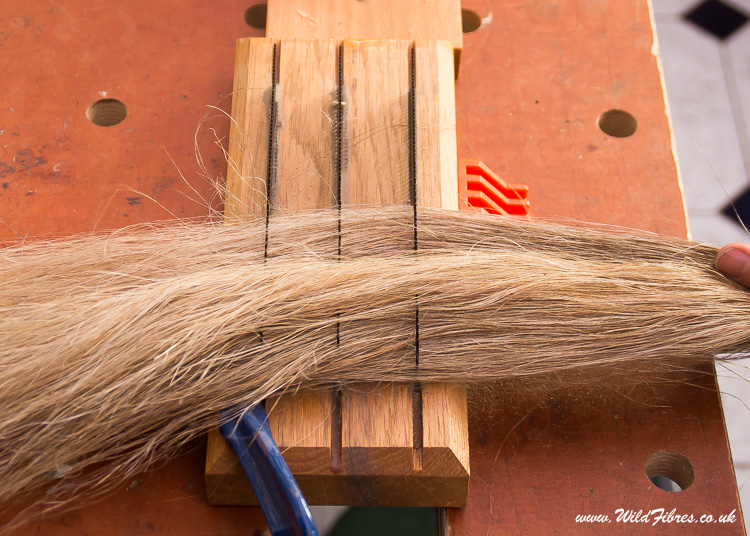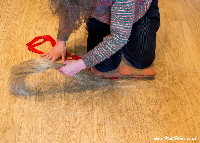|
 You will find it much easier to spin flax from a well-dressed distaff but it takes time and practice to dress the distaff properly. Depending on how much flax you are using, it can take from 20 to 40 minutes to dress the distaff, so make sure you are not going to be interrupted half-way through. Before you dress the distaff you need to prepare the strick and spread the flax. There are several ways of spreading the flax and several shapes of distaff. Here you will find instructions for fanning the flax to dress a cone distaff. I learnt how to dress a distaff from Diane Wood and Ann Cooper. You will find it much easier to spin flax from a well-dressed distaff but it takes time and practice to dress the distaff properly. Depending on how much flax you are using, it can take from 20 to 40 minutes to dress the distaff, so make sure you are not going to be interrupted half-way through. Before you dress the distaff you need to prepare the strick and spread the flax. There are several ways of spreading the flax and several shapes of distaff. Here you will find instructions for fanning the flax to dress a cone distaff. I learnt how to dress a distaff from Diane Wood and Ann Cooper.
i) Prepare the flax strick
ii) Choose the most suitable distaff dressing method
iii) Fanning the flax for the distaff (opens a new page)
iv) Dress the distaff (opens a new page)
i) Prepare the flax strick
 Before you start, have a look at the strick. You will find that one end is thicker than the other, the root end is the thick end. If you cannot find the root end, don’t worry, it does not matter too much. Before you start, have a look at the strick. You will find that one end is thicker than the other, the root end is the thick end. If you cannot find the root end, don’t worry, it does not matter too much.
Do not use the whole strick at once, as it is too much. Instead, split a finger of flax (25 to 50 grams) from the flax strick.
It is best to gently hackle the finger of flax, once more, just before dressing the distaff. If you don’t have a fine hackle you can comb it with a dog comb, starting close to one end and going towards the middle (a bit like untangling long hair), then starting at the other end and meeting in the middle. This final combing is very important, do not be tempted to miss this step.
ii) Choose the most suitable distaff dressing method (see A, B & C below)
Follow the instructions below carefully. You may find it useful to refer to the instructions every time you dress a distaff. You will need a long ribbon in a slippery material (about three metres long and 2.5 cm wide). Read the instructions below and then decide if you are going to fan the flax on a table, on the floor or on your lap.
A) On your lap
You will find it much easier to see the flax if you wear a dark coloured apron. Open your legs wide under the apron to provide a supporting surface for the flax. Fanning the flax on your lap is more professional and looks good at a demonstration however it can be a bit tricky to take the fanned flax from your lap to the distaff.
B) On a table
If you are a beginner, you may find it easier to fan the flax on a large rectangular table and then just roll the distaff over the fanned flax.
|

|
|
Fanning flax on the floor
|
|
C) On the floor
If there are no rectangular tables available, you can fan the flax on the floor. This can be harder on the back and you will need a cushion under your knees. Again, when you finish, you can roll the distaff over the fanned flax.
If you have decided to fan the flax on your lap or on a table, first tie the long ribbon round your waist by placing the centre of the ribbon against your stomach and the two ends at the back. Then pass the two ends round the back and bring them to the front. Tie the two ends in a bow knot. Use the loops of the bow to tie the root end of the strick (the thicker end) to your waist. The tie can be from 10 to 30 cm from the very end of the strick, depending on how well the strick was prepared. You will now look as if you have a horse’s tail coming from your front! Tuck the root end out of the way under the ribbon.
If you are fanning the flax on the floor, put a cushion on the floor and kneel on it. Instead of tying the ribbon to your waist, tie a ribbon to the end of your strick and tuck it under the cushion. Fan the flax as described below, but do it on the floor in front of you.
Next page:-
iii) Fanning the flax for the distaff (opens a new page)
And:-
Spinning flax & flax distaffs
a) Types of flax distaff
b) Making a cone distaff
c) Preparing flax for the distaff (this page)
d) Dressing a flax distaff
e) Spinning flax from a distaff (in preparation)
And Growing your own Flax.
top of page
|

